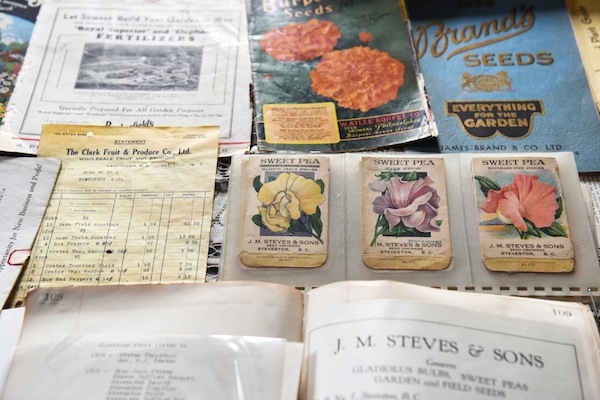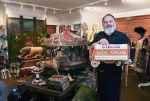Yosef Wosk with his collection of circus memorabilia, some of which can be seen in the Museum of Vancouver exhibit All Together Now: Vancouver Collectors and Their Worlds. (photo by Rebecca Blissett)
Prosthetics. Menus. Corsets. Artificial eyes. Seeds. Public transit documents. One wouldn’t necessarily think of these items as “collectibles,” yet they form part of a new exhibition that opened on June 23 at the Museum of Vancouver (MOV).
All Together Now: Vancouver Collectors and Their Worlds presents wall-to-wall displays of rare and unconventional items from 20 local collectors. Rounding out each exhibit is an opportunity for a fun, hands-on experience and a profile of the collector, including his or her motivations for collecting.
The exhibition explores the questions: Why do people collect and how do private collections touch public consciousness?
“The act of collecting is a fascinating way to engage with one’s identity, history and community,” Viviane Gosselin, curator of contemporary culture at the MOV, said in a release. “This exhibition enables visitors to enter into the rich, often unknown worlds of collectors and to think about how private collections can affect our understanding of the past. In this way, it reminds us of the importance of collectors as memory-keepers.”
Some of the exhibition’s “memory-keepers” include Imogene Lim, an anthropologist who collects Chinese-Canadian restaurant menus. She does so because they connect to her family story and her interest in intercultural history. David Moe collects vintage artificial limbs because they connect to his father’s profession and provide insight into the development of medical technology.
Gosselin noted that many of the collections form the basis for larger conversations about important societal issues. For example, Harold Steves’ collection of heirloom seeds ties to environmental history and issues of sustainability and food security. Prosthetics stimulate discussions about visibility, accessibility, social stigmas associated with disability and prosthetic design developments.

For Yosef Wosk, whose circus memorabilia was chosen by MOV curators to feature in the exhibition, collecting represents “an assembly of ideas, feelings, interesting people, travels and experiences so that the whole world, in a way, is a great museum.” He believes that the selection of his circus memorabilia for exhibition was “serendipitous,” as he considers the circus a “metaphor for life … usually a joyous place and sometimes an adventure.”
Wosk has been an avid collector of art and other diverse objects for many years. His 20 different collections encompass paintings, sculptures, photographs, furniture, carpets, lamps, textiles, glass, books (subdivided into 15 to 20 categories), toys and religious articles, including Judaica. He cherishes his collection of Torah scrolls from around the world, including Syria, Yemen, Iraq, Iran, Morocco and Tunisia.
As a child, Wosk collected coins, stamps, marbles and comics, but he is nostalgic in remembering the purchase of his first piece of “real art” at the age of 16. It was a Japanese scroll that he decided was worthy of his entire summer salary as a junior counsellor at Camp Hatikvah.
Over the years, Wosk built up his collection while studying and working in different cities around the world, such as Jerusalem, New York, Toronto, Philadelphia and Boston. As a student in Toronto, he acquired (with the help of his father) an Andy Warhol screenprint, “Ten Portraits of Jews of the Twentieth Century,” which he kept in a cardboard case under his bed.
Perhaps naturally, it was in Jerusalem that Wosk started to collect Judaica. Noting that, “collecting is an external manifestation of inner thoughts, feelings and spirituality,” he regards his Jewish collections, in particular, as an appreciation of Creation. He points out that the first description of G-d in the Torah is as an artist, as Creator. Moreover, the earth, and everything that fills it, is G-d’s collection. As such, Wosk has a profound appreciation for human creativity as an extension of the individual but, ultimately, of G-d. “That is how I feel about the collection, which is part of the world and the universe, which emanates from the Creator,” he said.
Wosk also believes that, as a collector, he has a responsibility to share his prized possessions with others.
“Sharing is as important as the collecting,” he said. “I find that collecting is not just owning, but along with ownership comes responsibility … to the object, the artist and the community.”
Wosk also emphasized, “People shouldn’t be afraid to collect and give it away.” He is a proud patron of the arts, serving on local and national boards of directors for various museums and art organizations (he was a founder of the Jewish Museum and Archives of British Columbia), donating art to hospitals and institutions of higher learning, and lending his collections to different exhibitions. His collection of Judaica has been displayed in Philadelphia and Boston, as well as in Vancouver, including at the Jewish Community Centre of Greater Vancouver’s Sidney and Gertrude Zack Gallery. He hopes to coordinate an exhibition in Israel in the future.
Wosk’s remarkable collections, and his enthusiasm to share his “wealth” with diverse communities, warrants his honorific as a “memory-keeper.” For a man who once worked as a teaching assistant for one of the greatest memory-keepers in history, the esteemed Elie Wiesel, this is perhaps not so serendipitous.
All Together Now: Vancouver Collectors and Their Worlds is at the Museum of Vancouver until Jan. 8, 2017. If you fancy yourself a collector and would like to participate in this exhibition, the MOV invites the public to post pictures of themselves with their collections on social media using the hashtag #mycollectionatMOV. Images will be projected onto a wall of photos. For more information, visit museumofvancouver.ca.
Alexis Pavlich is a Vancouver-based freelance writer.

